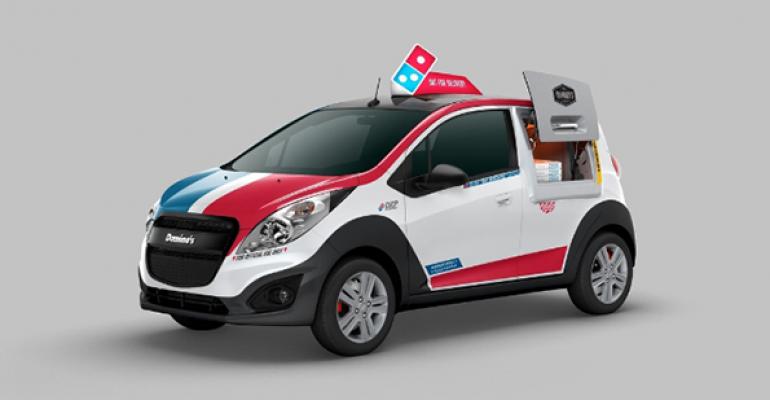One of the biggest challenges of restaurant delivery is how to keep food warm from the time it leaves the oven to when it reaches its destination.
Ann Arbor-based Domino’s Pizza Inc. may have solved this problem with the help of some local Michigan friends: It put a warming oven inside a Chevy.
On Wednesday, the pizza delivery chain launched the “Domino’s DXP,” a vehicle with a warming oven and a gutted interior for especially large orders. The company worked with Kenneth R. Baker, former research and development executive at General Motors, along with Michigan-based Roush Enterprises.
The 12,000-unit Domino’s also received ideas from an online crowdsourcing competition hosted by Local Motors, a technology company that designs, builds and sells vehicles.
“The Domino’s DXP is the first purpose-built vehicle aimed at revolutionizing pizza delivery,” Russell Weiner, president of Domino’s USA, said in a statement. “This innovation allows drivers to do their jobs with greater ease and efficiency, and demonstrates that Domino’s is absolutely fanatical about making perfect deliveries.”
The design and production of the DXP took three years. The design competition, Domino’s Ultimate Delivery Vehicle Challenge, fielded 385 entries from designers around the world. Roush and Baker then worked with Domino’s to transform the Chevrolet Spark into a delivery vehicle for pizza and other menu items.
The biggest feature is a Domino’s-branded warming oven located behind the driver’s door, and storage areas for easy loading and unloading of pizzas. The warming ovens can hold two Heatwave bags, and drivers can access them with the touch of a key fob.
The interior includes front and rear storage areas and includes a non-slip, easy-to-clean surface to stabilize items during delivery. And forget about passengers: All but the driver’s seat has been removed to enable the car to hold large orders of up to 80 pizzas for schools, businesses and special events.
The car has a puddle light that projects Domino’s logo on the ground. The logo also appears on the side panels, hubcaps and car topper.
The car gets 39 miles per gallon, which “should provide the kind of fuel economy franchisees welcome,” the company said in its release.
There’s no indication that the vehicle will completely replace the chain’s standard delivery cars yet. Domino’s plans to work with Roush to convert 100 DXPs and deliver them to 25 major markets, including Boston, Dallas, Detroit, Houston, Indianapolis, New Orleans, San Diego and Seattle, over the next 90 days. The company has contracted with Chevrolet dealers in those cities to deal with the nuances of the car. It is also working with franchisees to hold launch events.
“Even though Domino’s deliveries will still primarily be made in the personal cars of delivery drivers,” Weiner said, “the Domino’s DXP represents an innovative leap into the 21st century, and takes delivery to a new level of efficiency and quality.”
The effort continues a period of innovation at the delivery giant, but also represents a firm commitment to delivery — an area of increasing competition as startup delivery concepts and established chains aim to take a bite out of the market.
Pizza delivery represents two-thirds of Domino’s business, and the chain delivers about 400 million pizzas a year in the U.S. alone. Delivery drivers cover about 10 million miles each week — equivalent to 21 round trips to the moon, the company said.
The vehicle comes as Domino’s has given customers numerous new ways to order their pizza, through smartphone apps, Twitter, text and online orders. Digital orders now make up more than half of Domino’s orders. They also appear to be helping the chain generate sales: U.S. same-store sales rose 10.5 percent in the company’s recently completed third quarter.
Contact Jonathan Maze at [email protected].
Follow him on Twitter: @jonathanmaze




